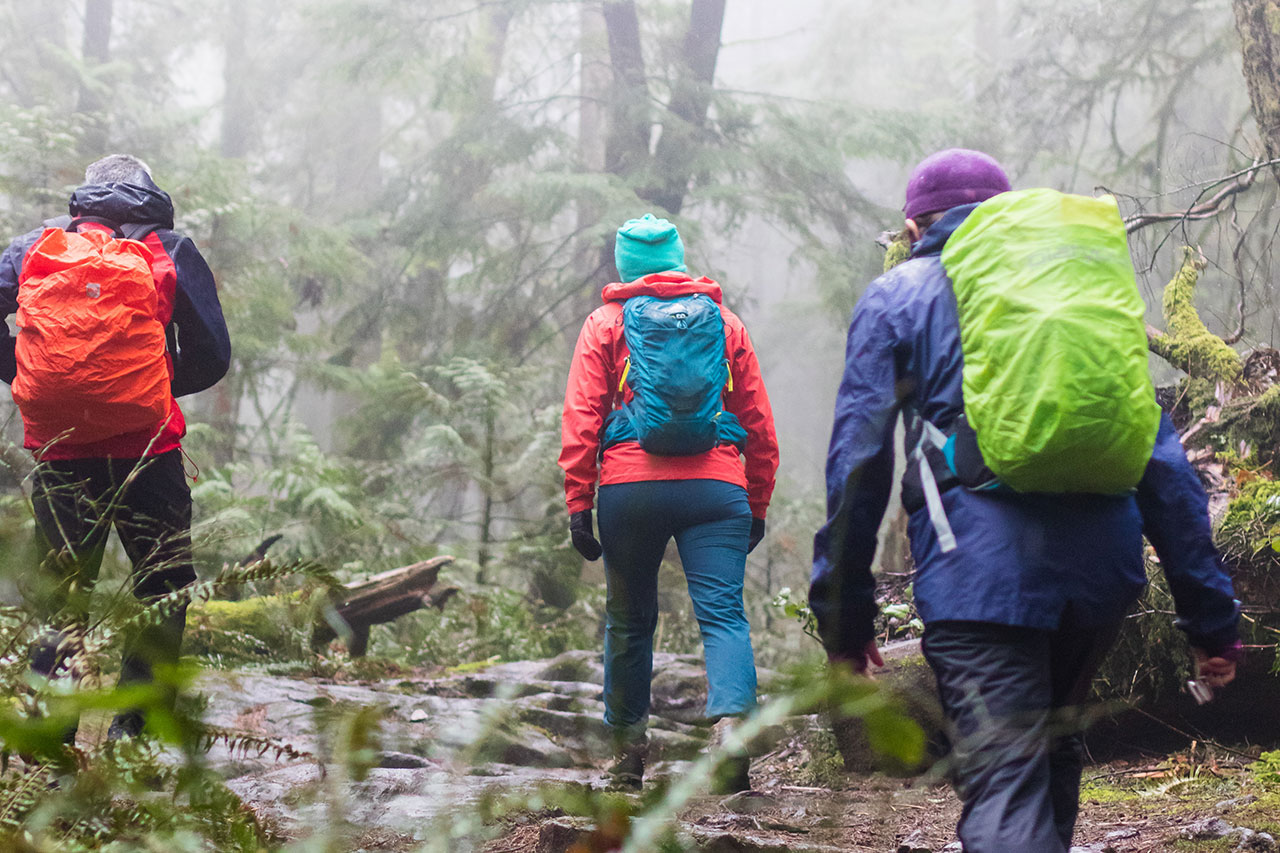Many hikers dash for cover when the skies open up. But equipped with proper gear, mindset, and etiquette, hiking in the rain can be an incredibly rewarding wilderness experience. Trails transform when soaked – colors become more vivid, scents more earthy, and the pattern of raindrops sets a zen-like mood. Use this complete guide to understand how to properly prepare for, safely enjoy, and hike responsibly when heading out on trails in rainy conditions.
Table of Contents
You may also want to know: How to start hiking
Packing the Right Gear for Hiking in the Rain
Quality waterproof clothing and equipment make all the difference for comfort and safety when hiking in the rain. Be sure to pack:
- Rain jacket – Breathable with fully sealed seams and storm hood. Bring lightweight and insulated versions to layer based on temperatures.
- Rain pants – Provide full leg coverage for protection from brush and mud. Avoid shorts.
- Waterproof hiking boots with rugged lug soles – Mesh fabrics will soak through. Prioritize ankle support and grip.
- Quick-dry merino wool or synthetic socks – Wicks away moisture and retains warmth when wet.
- Water-resistant backpack and pack liner – Prevents soaked gear and supplies inside. Trash compactor bags work as budget-friendly pack liners.
- Umbrella – Provides rain protection when stopped or taking a break.
- Second base layer – Having dry clothes to change into is comforting if truly soaked.
- Winter hat, gloves, and neck gaiter – Retains warmth if temperatures drop.
- Microspikes or crampons – Traction for icy trail conditions.
- Trekking poles – Improves stability with 4 points of contact on slick surfaces.
Waterproof everything to stay drier. Avoid cotton that gets cold and heavy when wet.
Pre-Hike Checks Before Heading Out Hiking in the Rain
Take these preparations when hiking in soggy conditions:
- Check the weather forecast and radar – Know the specific timing of expected showers. Plan the route accordingly.
- Learn flash flood risks – Avoid narrow canyons and valleys during potential thunderstorms.
- Identify alternate bailout points – Have shorter escape routes mapped out if the weather rapidly worsens.
- Tell someone your plans – In case of an emergency, share when and where you’ll be hiking.
- Pack critical items in waterproof bags – Electronics, phone, wallet, car keys, etc.
- Apply anti-fog treatment to glasses – Improves visibility in rain and fog.
- Check for trail closures – Many parks prohibit trail use during heavy rain or storms. Respect all closures.
Being prepared allows you to hike intentionally when wet weather hits rather than being caught off guard.
Hiking Safely in the Rain
Use these precautions for safe hiking in the rain:
- Slow pace and hike cautiously – Prioritize stability over speed on slick surfaces.
- Stay on the main trail – Avoid widening paths by walking through muddy areas or standing water.
- Use trekking poles – Improves balance and stability with 4 points of contact.
- Watch for floodwaters – Avoid crossing rivers or streams that have risen significantly from rainfall.
- Stop hiking if lightning nears – Wait out thunderstorms in a low-lying area away from tall trees.
- Monitor weather patterns – Know when to expect showers based on wind shifts and cloud movement.
- Carry emergency supplies – Headlamp, Mylar blanket, extra food, whistle, power bank, first aid.
Staying alert helps avoid falls and react promptly to changing trail conditions.
Practicing Leave No Trace Ethics When Hiking in the Rain
Use these tips for low-impact hiking in the rain:
- Walk single file in the center of the trail – Avoid widening paths around muddy areas.
- Pack out all trash – Don’t bury trash thinking rain will conceal it. Leave no trace.
- Urinate on durable surfaces – Limit urinating on vegetation to reduce concentrated ecological impact.
- Avoid building rock cairns or structures – Rain erodes unnatural formations back into sediments best left undisturbed.
- Don’t rely on washing in streams – Use biodegradable soap 200 feet from water sources.
- Stay on designated trails – Avoid trampling delicate rain-soaked vegetation.
The dampness amplifies hiking’s ecological impact if improper techniques are used. Tread lightly with leave no trace ethics in mind.
After-Hike Care When Returning From the Rain
Use these tips when finishing a soggy hike:
- Remove wet gear promptly – Change into dry clothes to avoid chilling.
- Dry electronic devices with rice – Absorbs ambient moisture from speakers or charging ports.
- Stuff shoes with newspaper – Absorbs moisture and helps shoes retain shape as they dry.
- Wash and dry any clothing to prevent mildew smells – Use an anti-microbial spray on technical fabrics prone to retaining odors.
- Take a warm post-hike shower – Avoid hypothermia from wet hikes in cool weather.
- Monitor for flu-like symptoms – Get medical care if showing signs of potential hypothermia like shivering, fatigue, or confusion.
With the proper hiking mindset, rainy excursions create indelible memories unique from dry weather days. The smells, sounds, views, and feelings get etched deeply into your senses. Just take reasonable safety precautions, limit ecological impact, and respect trail regulations when showers occur. Remember, there’s no bad weather, just unsuitable gear. Stay dry inside and out, and you’ll emerge rejuvenated by nature’s gift of rainfall.
Related Links:
https://en.wikipedia.org/wiki/Hiking
